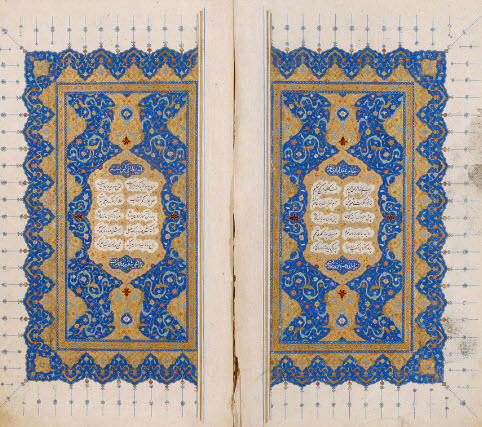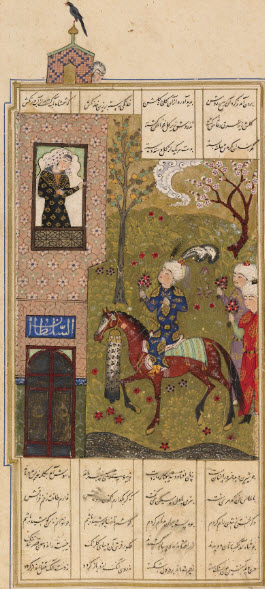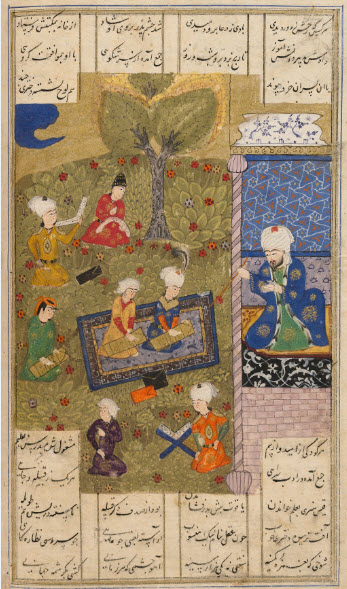“Possessing a treasure like my “Makhzan al-Asrar”
Why should I bother myself with romances?
In today’s world, however, there is no one
Who hasn’t a passion for romances.”
Nizami1
Nizami Ganjavi, one of the greatest romantic poets in Persian literature, was born in 1141 in Ganja, modern-day Azerbaijan and lived at a time of intense intellectual activity. A prominent poet acquainted with Arabic and Persian literature, he was also learned in mathematics, astronomy, medicine, botany, and the Qur’an.
Nizami composed qasidas and ghazals, only a small number of which have survived, but is best known for his five long narrative poems which have been preserved in a collection titled Khamsa (The Quintet).

Written in masnavi style totalling 30,000 couplets, the Khamsa comprises five poems:The Storehouse of Mysteries (Makhzanol-Asrar), a philosophical treatise; and four romances: Khosrau and Shirin, Layla and Majnun, The Seven Princesses (Haft Paykar), and The Book of Alexander (Iskandarnama).
Khosrau wa Shirin is a fictional version of the story of the love of the Sassanian king Khosrau II (r. 590-628) for the Armenian princess Shirin who became his queen after a lengthy courtship strewn with difficulties including vanquishing his rival Farhad. Variants of the story were told under the title of Shirin and Farhad. Chelkowski states that Khosrau and Shirin “proved to be a literary turning point not only for Nizami but for all of Persian poetry. Its dazzling use of language reached new heights; its emphasis on human rather than heroic elements and its intense delineation of the inner life of a broad range of characters were entirely original” (Mirror of the Invisible World p 3).

One of the best-known stories of Nizami’s Khamsa is Layla wa Majnun, who met as school children and fell madly in love, but were forbidden to marry. Grief-stricken, Majnun retreated to the desert while Layla, in time, married a nobleman, but remained devoted to Majnun initiating several attempts to meet him. Eventually she died of a broken heart.


Source: State Library of Victoria
Chelkowski notes that Nizami broke with tradition in his treatment of women in the stories. Rather than treating them as items of property or focusing on the heroics of men as was customary, women in Nizami’s stories “are strong, subtle, and virtuous, and, at the same time, tender, passionate, and enchantingly beautiful; they have sharp, educated intellects. In Layla wa Majnun, boys and girls study in the same classroom from the same master, and in other romances women are depicted as excelling in horsemanship and marksmanship” (Mirror of the Invisible World p 4).
It is generally agreed that the beauty of the Khamsa is unsurpassed in Persian literature, becoming the model for later poets of Romance literature. “These epic poems display Nizami’s genius for linguistic invention and psychological characterisation — a talent imitated by hundreds of poets since his time, but never equalled” (Chelkowski, Mirror of the Invisible World p i)
Puccini’s (d. 1924) last opera Tarandot was based on Nizami’s Seven Princesses. In the late 1960s, Eric Clapton (b. 1945) wrote his best-selling song Layla, inspired by the female beloved of Nizami’s story.2 Azerbaijan’s celebrated composer Gara Garayev (d.1982) wrote a symphony titled Leyli and Mejnun, as well as Seven Beauties, both based on Nizami’s Khamsa for which he received the Stalin Prize in 1946 and 1948 respectively.
Sources:
1Peter J. Chelkowski, Mirror of the Invisible World: Tales from the Khamseh of Nizami, The Metropolitan Museum of Art, New York: 1975
2Exhibition: Love and Devotion: From Persia and Beyond
Metropolitan Museum of Art
